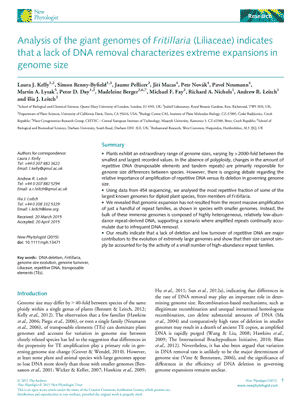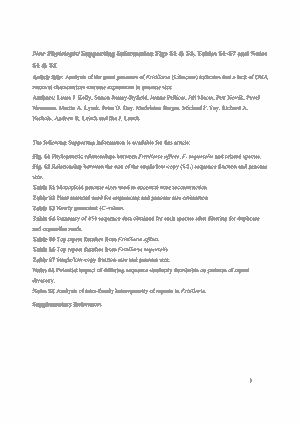NEWS 2015
Analysis of the giant genomes of Fritillaria (Liliaceae) indicates that a lack of DNA removal characterizes extreme expansions in genome size
Laura J. KELLY¹,², Simon RENNY-BYFIELD¹,³, Jaume PELLICER², Jiří MACAS⁴, Petr NOVÁK⁴, Pavel NEUMANN⁴, Martin A. LYSAK⁵, Peter D. DAY¹,², Madeleine BERGER²,⁶,⁷, Michael F. FAY², Richard A. NICHOLS¹, Andrew R. LEITCH¹, Ilia J. LEITCH²
New Phytologist 208: 596–607 (2015)
doi: 10.1111/nph.13471
¹School of Biological and Chemical Sciences, Queen Mary University of London, London, E1 4NS, UK
²Jodrell Laboratory, Royal Botanic Gardens, Kew, Richmond, Surrey TW9 3DS, UK
³Department of Plant Sciences, University of California Davis, Davis, CA 95616, USA
⁴Biology Centre CAS, Institute of Plant Molecular Biology, CZ-37005, České Budějovice, Czech Republic
⁵Plant Cytogenomics Research Group, CEITEC – Central European Institute of Technology, Masaryk University, Kamenice 5, CZ-62500, Brno, Czech Republic
⁶School of Biological and Biomedical Sciences, Durham University, South Road, Durham DH1 3LE, UK
⁷Rothamsted Research, West Common, Harpenden, Hertfordshire, AL5 2JQ, UK
Abstract
Plants exhibit an extraordinary range of genome sizes, varying by > 2000-fold between the smallest and largest recorded values. In the absence of polyploidy, changes in the amount of repetitive DNA (transposable elements and tandem repeats) are primarily responsible for genome size differences between species. However, there is ongoing debate regarding the relative importance of amplification of repetitive DNA versus its deletion in governing genome size.
Using data from 454 sequencing, we analysed the most repetitive fraction of some of the largest known genomes for diploid plant species, from members of Fritillaria.
We revealed that genomic expansion has not resulted from the recent massive amplification of just a handful of repeat families, as shown in species with smaller genomes. Instead, the bulk of these immense genomes is composed of highly heterogeneous, relatively low-abundance repeat-derived DNA, supporting a scenario where amplified repeats continually accumulate due to infrequent DNA removal.
Our results indicate that a lack of deletion and low turnover of repetitive DNA are major contributors to the evolution of extremely large genomes and show that their size cannot simply be accounted for by the activity of a small number of high-abundance repeat families.


